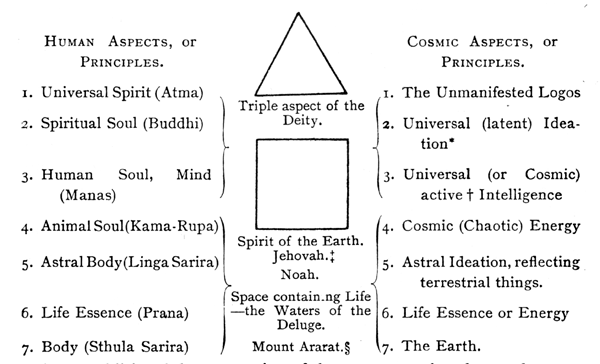Principle
Principle (from the Latin principium, meaning "beginning, foundation") is a technical term used in Theosophy, which refers to "a fundamental essence, particularly one producing a given quality."[1] In this view, there are seven principles constituting both the universe and human beings:
Principles. The Elements or original essences, the basic differentiations upon and of which all things are built up. We use the term to denote the seven individual and fundamental aspects of the One Universal Reality in Kosmos and in man. Hence also the seven aspects in the manifestation in the human being—divine, spiritual, psychic, astral, physiological and simply physical.[2]
Seven principles in human beings
The first publication describing the seven principles in human being was in A. O. Hume's "Fragments of Occult Truth." The information came as a result of his correspondence with some of the Mahatmas, part of which was published in the book The Mahatma Letters to A. P. Sinnett. Below is hia description:
1. The Physical body, composed wholly of matter in its grossest and most tangible form.
2. The Vital principle --- (or Jiv-atma) ---, a form of force, indestructible and when disconnected with one set of atoms, becoming attracted immediately by others.
3. The Astral body (Linga Sharira) composed of highly etherialized matter; in its habitual passive state, the perfect but very shadowy duplicate of the body; its activity, consolidation and form depending entirely on the kama rupa.
4. The Astral shape (kama rupa) or body of desire, a principle defining the configuration of--
5. The animal or physical intelligence or consciousness or Ego, analogous to, though proportionally higher in degree than, the reason, instinct, memory, imagination, &c., existing (1) in the higher animals.
6. The Higher or Spiritual intelligence or consciousness, or spiritual Ego, in which mainly resides the sense of consciousness in the perfect man, though the lower dimmer animal consciousness co-exists in No. 5.
7. The Spirit --- an emanation from the ABSOLUTE; uncreated; eternal; a state rather than a being.[3]
In 1883 A. P. Sinnett, the main correspondent of the Mahatma Letters published the seven principles adding the Sanskrit names:
1. The Body . . . . . . . Rupa.
2. Vitality . . . . . . . . . Prana, or Jiva.
3. Astral Body. . . . . . Linga Sharira.
4. Animal Soul. . . . . . Kama Rupa.
5. Human Soul. . . . . . Manas.
6. Spiritual Soul. . . . . Buddhi.
7. Spirit . . . . . . . . . . . . Atma.[4]
In 1889, the seven principles were explained by Mme. Blavatsky as follows:
LOWER QUATERNARY
(a) Rupa, or Sthula-Sarira -- Physical body -- Is the vehicle of all the other "principles" during life.
(b) Prana -- Life, or Vital principle -- Necessary only to a, c, d, and the functions of the lower Manas, which embrace all those limited to the (physical) brain.
(c) Linga Sharira -- Astral body -- The Double, the phantom body.
(d) Kama rupa -- The seat of animal desires and passions -- This is the centre of the animal man, where lies the line of demarcation which separates the mortal man from the immortal entity.
THE UPPER IMPERISHABLE TRIAD
(e) Manas — a dual principle in its functions -- Mind, Intelligence: which is the higher human mind, whose light, or radiation links the MONAD, for the lifetime, to the mortal man -- The future state and the Karmic destiny of man depend on whether Manas gravitates more downward to Kama rupa, the seat of the animal passions, or upwards to Buddhi, the Spiritual Ego. In the latter case, the higher consciousness of the individual Spiritual aspirations of mind (Manas), assimilating Buddhi, are absorbed by it and form the Ego, which goes into Devachanic bliss.
(f) Buddhi -- The Spiritual Soul -- The vehicle of pure universal spirit.
(g) Atma -- Spirit -- One with the Absolute, as its radiation.[5]
Individuality and personality
The division of the principles into the lower quaternary and the upper or higher triad gives rise to an important classification, that of individuality and personality:
The teachings of Occultism divide man into three aspects -- the divine, the thinking or rational, and the irrational or animal man. For metaphysical purposes also he is considered under a septenary division, or, as it is agreed to express it in theosophy, he is composed of seven "principles," three of which constitute the Higher Triad, and the remaining four the lower Quaternary. It is in the latter that dwells the Personality which embraces all the characteristics, including memory and consciousness, of each physical life in turn. The Individuality is the Higher Ego (Manas) of the Triad considered as a Unity. In other words the Individuality is our imperishable Ego which reincarnates and clothes itself in a new Personality at every new birth.[6]
Thus, Individuality refers to the three higher principles (ātman, buddhi and manas) or, more specifically, to the fifth principle, the higher manas or reincarnating Ego, while the Personality refers to the [[Quaternary#Lower quaternary in human beings|four lower principles, namely the physical body, liṅga śarīra, prāṇa and kāma.
Comparison between the principles in human beings and cosmos
Mme. Blavatsky compared the seven principles in cosmos and human beings as follows:[7]
Notes
- ↑ Principle at Wiktionary
- ↑ Helena Petrovna Blavatsky, Theosophical Glossary (Los Angeles, CA: Theosophy Company, 1973), 262-263.
- ↑ See Fragments of Occult Truth No. 1 at Blavatsky Study Center
- ↑ Alfred Percy Sinnett, Esoteric Buddhism (San Diego, CA: Wizards Bookshelf, 1987), 24.
- ↑ Helena Petrovna Blavatsky, Key to Theosophy, (London: Theosophical Publishing House, 1987), 92.
- ↑ Helena Petrovna Blavatsky, Key to Theosophy, Glossary (Pasadena, CA: Theosophical University Press, 1972), 359.
- ↑ Helena Petrovna Blavatsky, Secret Doctrine vol. II (Adyar, Madras: Theosophical Publishing House, 1979), 596.
